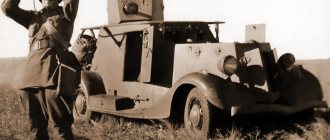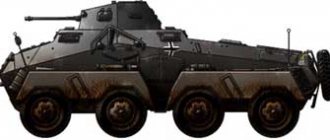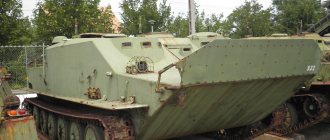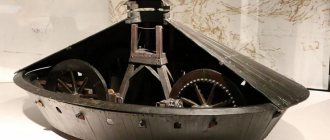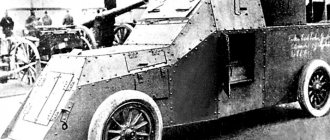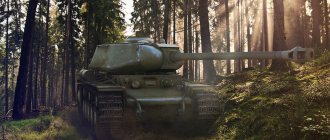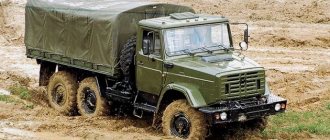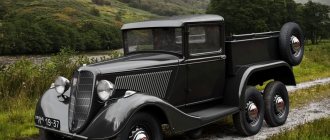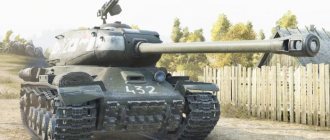History of creation
Since 1933, Leningrad began producing the FAI light armored car (Ford-A Izhorsky).
However, already in 1935, the experience of operating the FAI among the troops showed that the armored car was inferior in cross-country ability even to passenger cars. In addition, the weight of the structure led to increased wear of the chassis. And nothing could be done about it - Ford-A (under the GAZ-A brand) at that time was the only production passenger car in the USSR. But already next year the Gorky Automobile Plant mastered a new car - the M-1. "Emka" had a more powerful 4-cylinder engine, a reinforced frame, and, in general, was better suited for use as the basis of an armored vehicle.
Serial production of the armored car began in 1936 at the Vyksa plant. At the same time, in parallel with the BA-20, the production of FAI-M was organized - the old armored hulls were rearranged on the GAZ M-1 chassis.
The history of the creation of the LB-62 armored car
The Soviet all-wheel vehicle LB-62 (“LB” - “Lavrenty Beria”) was developed and manufactured at the Gorky Automobile Plant in 1940 using the chassis of a prototype GAZ-62 all-wheel drive truck.
In terms of its characteristics, the LB-62 armored car was superior to all previous types of armored vehicles, essentially being a wheeled tank, with the level of armor protection and armament similar to the T-40 light tank.
By 1941, two prototypes of LB-62 armored vehicles were manufactured. The tests ended closer to the spring of 1941, but when the logical question of serial production of the new armored car was raised, GAZ “reared up.”
Both manufactured LB-62 armored vehicles are being tested
The plant was overloaded with orders from the automotive industry, and in addition it also produced aircraft engines - there was enough work on old orders. There could be no talk of any launch into production of not only the newest armored car LB-62, but even the truck (GAZ-62), on the basis of which this armored car was supposed to be assembled.
Production of the LB was postponed to the next year, 1942, but within a few months the war began, and these plans had to be forgotten. All that remains of the promising and (most likely) best Soviet armored car LB-62 are two experimental vehicles that were built back in 1940.
One of the LB-62 armored cars overcoming a water barrier
Combat use of armored vehicles BAI, BA-3, BA-6
Armored vehicles BA-3 and BA-6 entered service with reconnaissance units of tank, cavalry and rifle formations of the Red Army, and most of them were concentrated in the Far East.
Three brigades (7,8,9) each with 80 medium and 30 light armored vehicles took part in the battles with Japanese troops near the Khalkhin Gol River. In the period from 1936 to 1938 7 BAI and 80 BA-6 were delivered to Spain, where the BA-6 successfully fought against enemy tanks. The remaining armored cars served in Spain until the 50s. These vehicles were supplied to Turkey (BA-3) and Mongolia.
In the west, BA-3 and BA-6 took part in the Polish campaign, in the Soviet-Finnish War (the Finns captured several BA-6s and operated them until the mid-50s of the 20th century) and, in some numbers, in the Great Patriotic War, where mentions of them occur before 1942.
USSR armored vehicles - BA-10, BA-11, BA-20, BA-27, LB-62
Vehicles of this type were created on special AMO-F-15 chassis. The housings for these chassis, as well as the assembly, were produced by the Izhora plant near Leningrad, known back in 1914-1919 for the manufacture and repair of armored vehicles. His model BA-27 on the AMO-F-15 chassis began to be produced in small series since 1928. The vehicle had a riveted body made of armor plates 4-7 mm thick and was armed with a 37 mm cannon and a 7.62 caliber machine gun located in a rotating turret.
The AMO-F-15 chassis for the BA-27 has a reinforced frame and springs - after all, with the armored body that the Izhora plant mounted on them and weapons, the combat weight of the BA-27 was 4.4 tons. The vehicle was equipped with an electric starter and lighting, an additional tank, with larger cross-section tires and an upgraded cooling system. In accordance with the accepted driver's position, the steering column received a greater angle. The first production BA-27 vehicles were equipped with a second, rear control station, so its crew initially consisted of four, and later of three people. BA-27 reached a speed of 40 km/h. When the assembly of Ford-AA and Ford-Timken trucks began in Moscow at the KIM plant, and then in Gorky at Gudka Oktyabrya, their chassis served to create new armored cars. The BA-27 bodies began to be mounted in 1930 on the Ford-AA chassis, and from 1931 the plant installed a converted armored body on the Ford-Timken chassis - the result was the BA-27M model. Another 1931 model on the same chassis was the D-13 with spare wheels located along the sides and able to rotate.
N. I. Dyrenkov played an active role in the creation of new armored vehicles at the Izhora plant. A man with remarkable ingenuity, he very quickly found the necessary technical solutions. So, during a visit to the plant by one of the deputy people's commissars of defense in 1931, he, looking through the American army magazine "Army Ordnance" in Dyrenkov's office, drew the attention of the owner of the office to the latest models of US armored vehicles. They had a low silhouette and heavily angled armor plates that facilitated the ricocheting of bullets. Dyrenkov replied that he was already working on a similar model and was ready to demonstrate it tomorrow. After the guest left, Dyrenkov ordered the passenger body to be removed from his official car, called a carpenter, and by evening there was already a plywood model on the chassis with traces of a pencil, which the inventive engineer used to mark patterns directly on the sheets of plywood. Then the model, fitted to the chassis, was disassembled and panels were cut out from armor plates using improvised plywood patterns, a body was assembled from them on a frame, and installed on the chassis.
The most labor-intensive process was drying an armored car painted with oil paint using blowtorches. But by noon, Dyrenkov was able to present to the distinguished guest the D-8 hull, ready for test firing, mounted on a chassis. It would be a mistake to equate the design of military equipment with such “window dressing,” but the example given illustrates the efficiency and ingenuity with which armored vehicles were created in the pre-war years. Sometimes unexpected designs were born, but in the stream of experiments it was possible to quickly find the right direction. With the start of production of GAZ-A vehicles, armored vehicles began to be created on their basis. So the D-8 (the letter “D” indicates the connection of the design with the same N.I. Dyrenkov) had a very low hull with a large slope of the sheets and without a turret. The armament was two machine guns, located in the front and rear plates. The vehicle turned out to be very light, weighing only 1580 kg, but its engine power and maneuverability were low, and the firing zone was limited.
The idea of a Civil War-era cart for an armored car did not justify itself. Also in 1931, the D-12 model was created, the same as the D-8, but with a modified shape of the rear part of the hull, where the anti-aircraft machine gun was located. Ultimately, from 1932, the D-8 was replaced by the FAI armored car, which had a rotating turret with a machine gun. The vehicle became taller (2240 mm instead of 1680 mm for the D-8), and its weight increased to 2000 kg. Later, in 1938, the GAZ-A chassis was replaced by the GAZ-M1 and the armored car became known as the FAI-M. And finally, in 1936, another plant, but also on the GAZ-M1 chassis, organized the production of the BA-20 car. Its production continued until the beginning of the Great Patriotic War, and this model, like its modernized version BA-20M, became the most popular wheeled combat vehicle of the Red Army.
The BA-20 was equipped with bullet-resistant tires filled with sponge rubber and a reinforced chassis. Its welded armored hull (sheet thickness 4-6 mm) had a turret with one machine gun. The combat weight was 2300 kg, and the highest speed was 90 km/h. But the vehicle had weak armament and armor protection, insufficient cross-country ability and traction properties (the maximum climbability was 15°). The BA-20M version, modernized in 1938, received a new conical turret, a radio station (the crew increased to three people), and an additional fuel tank. This led to an increase in combat weight to 2520 kg with all the ensuing consequences. Nevertheless, attempts to create light armored cars continued, since the army still needed a compact reconnaissance and communications vehicle. Three-axle prototypes were also built: on the GAZ-TK chassis in 1935, GAZ-21 and GAZ-22 in 1939, and then in 1940 the all-wheel drive LB-NATI and in the same year the LB-62, also all-wheel drive, but on based on a prototype of the GAZ-62 truck.
Equipped with an 85 hp GAZ-11 engine, an armored body made of 10-13 mm thick sheets, and three machine guns (one large-caliber, 12.7 mm), the LB-62 turned out to be a successful vehicle. Its combat weight was 5150 kg, and it was no longer classified as a light armored vehicle. The speed reached 70 km/h. This car was produced in 1940 in the amount of 60 copies, and it became the first serial Soviet all-wheel drive car (production of the GAZ-61 had not yet begun). As for heavy vehicles with cannon armament, they existed in a wide variety of models, but, alas, only on the basis of GAZ-AAA components and assemblies with an engine power of only 50 hp. and drive to two rear axles. At the Izhora plant, cannon armored vehicles were developed under the leadership of A.D. Kuzmin. The first production model armed with a 45 mm cannon was the BA-3 in 1934. It retained on-board rotating spare wheels, removable Over-Roll track chains, had a combat weight of 6000 kg, a crew of four, and 8 mm armor.
The armored car could reach a speed of 45 km/h. He was armed with a cannon in the turret of a T-26 tank and two machine guns. Subsequently, the firepower of the armored car increased, and the weapon aiming system became more modern. But the weight of the car was excessive. Therefore, the very next year the BA-6 appeared, whose weight was reduced by 880 kg even with the armor thickness increased to 9 mm. This is achieved thanks to the carefully thought out shape of the case. In 1936, the next stage was the BA-6M with a turret from the BT-7 tank, equipped with a radio station, a hull with 10 mm armor, and a 50-horsepower GAZ-M engine. But the weight did not increase: on the contrary, thanks to the development of details, it was already reduced to 4800 kg, and the maximum speed increased to 52 km/h. At the same time, the BA-9 armored car was produced, almost identical to the BA-6M, but armed not with a cannon and two 7.62 mm machine guns, but with one heavy machine gun (12.7 mm) and one regular caliber.
Working on the design step by step, the Izhorians came to the BA-10 model in 1938. Its features: a shortened frame and rear part of the body, a reinforced front axle beam, hydraulic shock absorbers, the thickness of armor plates increased in places to 15 mm, internal door hinges instead of external ones, armored headlight protection, a radio station and shielded electrical equipment. With a length of 4655 mm, width of 2070 mm, height of 2210 mm, the combat weight of the BA-10 was 5140 kg. With a 50-horsepower engine, the armored car could reach a speed of 53 km/h. Crew - four people. The BA-10M, a modernized model of 1939, has improved steering, increased armor protection for the radiator, and a new radio station. However, based on the experience of combat operations in 1939 at Khalkhin Gol, this vehicle turned out to be ineffective. At the front line and in the depths of the enemy’s defense, the BA-6 and BA-10 cannon armored vehicles were almost impossible to use due to their poor maneuverability.
Subsequently, production of the BA-10M was reduced and ended in the spring of 1941. These and other conclusions from combat practice forced our designers to turn to all-wheel drive vehicles. In addition to these models, three-axle armored vehicles BA-11, again 6X4, based on ZIS-6 units, were manufactured in 1939. Armed with a 45 mm cannon and two machine guns in an armored hull made of 13 mm thick sheets, they turned out to be very heavy (8130 kg) and, like their predecessor of 1935 (BA-5 on the ZIS-6 chassis), had poor maneuverability. Among the work on armored vehicles, the floating vehicles PB-4 (1935) and PB-7 (1937) based on GAZ-AAA units and components, produced in small series, are of interest. On the water they moved with the help of propellers, had poor maneuverability afloat and proved to be unreliable.
Further experiments in the field of armored vehicles went towards the creation of the BA-22 ambulance transport vehicle (1939) on the GAZ-AAA chassis. Its armored hull accommodated ten people and two crew. The weight of the BA-22 was 5240 kg, and the speed was 40 km/h. Another vehicle is the B-3 half-track armored personnel carrier (1939) based on ZIS units. Armed with a machine gun, it could carry 12 people. Its weight already exceeded 7000 kg. A small batch of BA-30 half-track armored vehicles based on the NATI-3 was built in 1937 and used in the winter of 1940 during the Finnish campaign. An interesting fact is that a number of BA-20 and BA-10 armored vehicles, captured as trophies in 1940, were later used by the Finnish army. The first of them, in the amount of 22 units, was even in service and individual copies were used as training ones until the beginning of the fifties. There were fewer BA-10 vehicles. On them, the original 50-horsepower GAZ-M engines were replaced with 85-horsepower Ford-U8 engines.
Design of the armored car LB-62
The welded body of the vehicle was made of rolled armor plates 4-13 mm thick, located at rational angles of inclination. The conical turret with an armor thickness of 10 mm was borrowed from the T-40 light tank.
The turret housed weapons similar to the T-40 and LB-NATI - a coaxial installation of DShK and DT machine guns (with the expectation of replacing the DShK with a 20-mm cannon in the future). Another DT machine gun was installed in a ball joint in the front hull plate to the right of the driver's inspection hatch. The ammunition consisted of 500 rounds of ammunition for the DShK machine gun and 3,150 rounds of ammunition for the DT machine guns.
Drawing-reconstruction of the LB-62 armored car in battle.
The high traction and speed qualities of the LB-62 were ensured by the use of a quite powerful for that time 6-cylinder four-stroke carburetor engine GAZ-202 with an output of 85 hp, also borrowed from the T-40 light tank. The maximum speed on the highway reached 70 km/h, the range was 500 km.
The mechanical transmission consisted of a single-disc clutch, a four-speed gearbox and two drive axles with worm final drives.
The wheels of the machine are single-pitch discs, with developed lugs of the “oblique Christmas tree” type. The tread pattern of these tires provided sufficient soil cutting area between the protrusions and good self-cleaning of the depressions, which was especially important when driving on clay soils.
LB-62, Armored car
Light armored car “LB-62”
The LB-23 armored car also did not fully satisfy the requirements of the military, so in 1940 prototypes of two-axle all-wheel drive (4x4) armored cars LB-62 and LB-NATI were built. The chassis of the experimental GAZ-62 all-wheel drive truck was used as the basis for the LB-62. The completely enclosed all-welded body of the armored vehicle had a well-thought-out rational shape and was made of sheets of rolled steel 10 mm thick. The armor of the frontal projection reached 13 mm. The upper parts of the sides converged upward, and the lower ones - downwards, so in cross-section the body of the armored vehicle had the shape of two trapezoids with a common base. Such armor protection reliably covered the crew of three people, as well as the main components and assemblies of the vehicle from damage by bullets and fragments of small-caliber shells and mines. To enter and exit the vehicle, there were rectangular doors on the sides of the hull that opened forward in the direction of travel.
In the control compartment on the left sat the driver, who watched the road through the front window, which in a combat situation was covered with an armored cover with a viewing slot. Additional visibility was provided by viewing slots in the side doors. All viewing slits were equipped with PT-K bulletproof observation devices. To the right of the driver sat the commander of the vehicle. In front of it, in the beveled frontal plate of the hull, a 7.62-mm DT machine gun was mounted in a ball mount. However, the commander had to not only fire from this machine gun, but also maintain communication using the 71-TK-1 radio station. At the rear of the hull, on the roof of the fighting compartment, a conical turret of circular rotation was installed, armed with a 12.7 mm DShK machine gun and a coaxial 7.62 mm DT machine gun. The ammunition for the heavy machine gun consisted of 500 rounds of ammunition and for the two DT machine guns - of 3,150 rounds. In a combat situation, visibility from the turret was provided by viewing slots in its sides. In a safer environment, it was possible to monitor the area through the upper turret hatch. In addition, if necessary, it was possible to leave the armored vehicle through it.
In the engine compartment located in the front of the vehicle, a six-cylinder carburetor in-line liquid-cooled GAZ-202 engine was installed, developing a power of 62.5 kW (85 hp), which allowed the armored vehicle with a combat weight of 5.15 tons to move on roads with hard surface with a maximum speed of 70 km/h. With full fuel tanks, the LB-62 could travel, depending on the condition of the road, from 360 to 500 km. The all-wheel drive (4x4) chassis with suspension on semi-elliptical leaf springs used single wheels with bullet-resistant ground-grip tires. The front and rear wheels were covered with multifaceted angular wings. A spare wheel was mounted on a special bracket on the stern plate of the hull. Headlights were installed on the front wings to ensure movement at night.
Overall, the LB-62 turned out to be a successful machine. A total of 60 armored vehicles of this type were produced, and thus the LB-62 became the first all-wheel drive vehicle in the USSR (the production of the GAZ-61 had not yet begun).
Tactical and technical characteristics of the LB-62 armored car
Combat weight, t: 5.15; Crew, people: 3; Overall dimensions, mm: length – 4430, width – 2000, height – 2240, ground clearance – 260; Armor, mm: hull front – 13, hull side – 10, turret – 10; Armament: 12.7 mm DShK machine gun, two 7.62 mm DT machine guns; Ammunition: 500 rounds of 12.7 mm caliber, 3150 rounds of 7.62 mm caliber; Engine: GAZ-202, 6-cylinder, carburetor, in-line, liquid cooling, power 62.5 kW; Specific power, kW/t: 12.14; Maximum speed, km/h: on the highway – 70; Cruising range on the highway, km: 360-500
Design of the LB-NATI armored car
The chassis of the LB-NATI armored car was based on the components and assemblies of the GAZ-MM truck (wheels, steering mechanism, frame elements, gearbox), but was modified by NATI. The frame was shortened, the wheelbase was reduced to 2750 mm, the springs were replaced with longitudinal semi-elliptical ones, and the front and rear wheel suspension was equipped with hydraulic shock absorbers.
The car received a 6-cylinder engine from GAZ-61 with a power of 76 hp. (it was originally planned to supply a Dodge with a power of 72 hp), as well as a two-speed transfer case with a built-in center differential, providing three options for transmitting torque: to all wheels, only to the rear, only to the front.
LB-NATI armored vehicle undergoing testing
Both LB-NATI drive axles were driven, the rear wheels were equipped with double ramps. Both front and rear wheels had developed lugs. The wheel hubs had armor protection, the gas tank was protected, protected from bullets and shrapnel. The wheels of the car were filled with gummatic.
The body of the LB-NATI armored car is completely welded, the sheets have a rational angle of inclination.
To accommodate a crew of three people, as well as, if necessary, a passenger, the car body had doors; in addition, the designers provided an emergency hatch in its floor.
The turret is conical, unified with the turret of the T-40 light tank. The armament was 1x 12.7 mm DShK machine gun, 1x 7.62 mm DT machine gun.
Communication between the crew and the command was carried out using the 71-TK-1 radio station with a whip antenna.
Author: Administrator | April 13, 2016
A prototype of the LB-62 (Lavrentiy Beria) was built at the Gorky Automobile Plant in 1940. The basis for the armored car was the GAZ all-wheel drive truck. Despite the fact that the plant had not previously produced such vehicles, the task was completed quite quickly, and on February 15, 1940, production of a mock-up of the new DB-62 armored car was completed.
The combat weight of the armored vehicle was 5150 kilograms, length – 4430 millimeters, width – 2000 millimeters, height – 2240 millimeters and ground clearance 260 millimeters. The LB-62 was equipped with a 6-cylinder liquid-cooled gasoline engine GAZ-202 with a specific power of 16.5 and a maximum of 85 horsepower. The armored car could reach speeds on the highway up to 70 kilometers per hour, the fuel supply was 150 liters, providing the armored car with a range of 360 to 500 kilometers.
The body of the armored car was made from welded armor plates at the Vyksa crushing and grinding equipment plant. The frontal armor of the hull was 13 millimeters thick, the turret was made of armor plates 10 millimeters thick.
The crew of the LB-62 armored car consisted of 3 people, a gunner, a driver, a mechanic and a vehicle commander.
The BL-62 was armed with a heavy-caliber DShK machine gun with a caliber of 12.7 millimeters and a coaxial blue DT machine gun with a caliber of 7.62 millimeters, which were installed in the rotating turret of the armored car. The third machine gun stood in the front plate to the right of the driver in a ball joint. For machine guns there was an ammunition load of 3150 rounds.
To communicate with the command, the armored car had a 71-TK-1 radio equipped with a whip antenna. You can learn more about military equipment and uniforms by visiting the online military store.
Production: Union of Soviet Socialist Republics. Crew: 3 people. Weight: 5150 kilograms. Dimensions: length – 4430 mm, width – 2000 mm, height – 2240 mm and ground clearance 260 mm. Armor: frontal hull 13 mm and turret 10 mm. Armament: two DT machine guns with a caliber of 7.62 millimeters and a large-caliber DShK with a caliber of 12.7 millimeters. Engine: 6-cylinder liquid-cooled gasoline engine GAZ-202 with a specific power of 16.5 and a maximum of 85 horsepower. Wheel formula: 6x4. Driving performance: maximum speed on the highway is 70 kilometers per hour. Fuel capacity: 150 liters. Power reserve: 500 kilometers.
Like
Military equipment
| < Previous | Next > |
Add a comment
Modifications
Some of the BA-20 armored vehicles were converted into BA-20zhd armored tires. Instead of ordinary wheels, railway wheels were installed on the armored car, and a range-multiplier was introduced into the transmission. At the same time, the possibility of quickly replacing the wheels with rubber ones remained, but the speed of movement dropped noticeably due to the range multiplier.
Based on the results of operation, the Emka chassis received a reinforced suspension, and an additional gas tank appeared that could hold 30 liters of fuel. The thickness of the front armor plates was increased to 9 mm. To improve bullet resistance, the armored car's turret took the shape of a cone with a flat frontal plate. The antenna in the form of a handrail was abolished, and the radio station was replaced with a modified 71-TK-3.
The modernized BA-20 also received a railway version - BA-20Mzhd. It also differed from the linear armored vehicle in the presence of a range of amplifiers and the installation of railway wheels.
